Archive for November, 2009
My room at Rothera
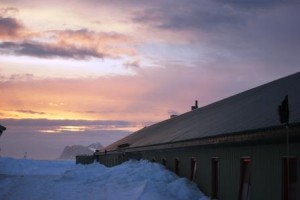
Several people have asked about where I am staying. I am in Admirals house which is a really nice accomodation block. My room overlooks the runway and the mountains beyond.
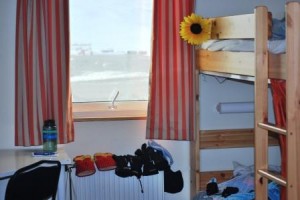
Thanks to Myles for my sunflower 🙂
Physical Activity
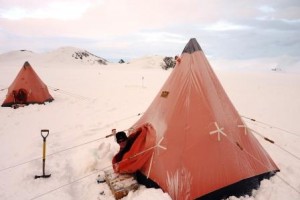
Clive the GA teaching us mountaineering skills promised us lots of physical activity and we did indeed get a lot! After packing up camp on thursday which meant lots of digging of snow from around the tents we headed back down to base in the snow cat and skidoos. We then kitted ourselves out in mountaineering equipment including boots, crampoons and ice axes. We all learnt how to tie together when glacier travelling so that if one person falls in a crevasse the other can haul them out.
We spent 4 hours behind the hanger on the icy sloop learning the 4 S’s – stepping, slipping, sliding and stopping (one GA added in screaming!). There are so many different techniques to learn. We also learnt how to use crampons and the different stepping techniques for going up and down the hill – french, front pointing, american and balling up. My legs really felt the work out as I spend so much time on my bum on a boat. The big one was learning to do an ice axe arrest in the case of falling down a slope towards a danger. Clive is a great teacher and built each skill up like building blocks.
We all had to learn how to hold an ice axe and then practice sliding feet first on our back, head first on our front and head first on our back down the ice and then stopping ourselves with the ice axe. By the end of the session we were all a bit bruised and cold and wet but it was really great fun. We didn’t finish all the mountaineering instruction so Clive is kindly giving up his day off this sunday and we are going to learn crevasse rescue and go for a climb in the technical travel area.
In the evening we went for a walk around Rothera point and watched the sun set as much as it does here at 11pm.
Rocking Horse Shit!
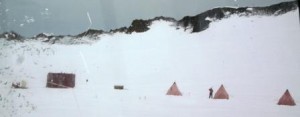
I am hanging out with the two Royal Navy guys one is a pilot and the other an observer. The title is a new saying I learnt from them it means something is very rare!
Well I am being given some rare opportunities down here that people would pay 1,000’s for. Yesterday and today we were doing what BAS calls jingle janglies.
Yesterday started with a 5km row on the rowing machine followed by an hour dissecting the field medical box with the Dr. The box has lots of great things in it and also going back over first aid stuff we learnt at conference including how to put a needle in someones chest cavity to sort out a collapsed lung and also injections concentrating on how to used powdered antibiotics.
The morning was spent learning how to use flares, vhf’s (a bit boring for me) and then how to use a tilley lamp and primus stove. You cook in the pyramid tents and have to know how to get the right time of flame so you don’t die from carbon monoxide poisoning. There are monitors for the CO in the tents so you don’t have to guess whether you are about to pass out or not.
We also received our P-rolls which are the bed rolls which go into the field. They are foam carry mats with a thermorest then a sheepskin then a -40 sleeping bag which has a fire retardent cover you put on top and then if you want more warmth a thick fleece liner. They are really warm and weigh around 30lbs so it is necessary to ‘car camp’ with these.
We packed all the gear into the skidoos and the snow cat and headed up the ‘Ramp’ to Vals which is a ski area 5km from base. There is a porta cabin on skis up there with a stove etc which you can go to for the weekends and this is also where the field training occurs. The picture up top is of our 3 tents after we pitched them. It takes a long time to pitch one of the pyramid tents properly. You have to dig a 4 meter by 4 meter square hole in the snow that is a shovel height deep orientated to the wind properly. You make this level and then dig a hole for each corner of the tent. So basically a lot of digging is involved.
We cooked our ‘manfood’ in the tent. Which is freeze dried meals from 2002! I am glad I am based on the base as the guys right now that are going into the deep field are going to be out for 60 to 90 days eating that stuff! We made an effort in Claire and I’s tent though and had a 5 course meal that wasn’t that bad. We started with ready salted crisps then ministrone soup and a main course of pasta carbonara. The palette cleanser was a orange granitta – snow with orange powdered drink! It takes a while to melt the snow to get water but there is an endless supply of snow to cool the drinks! After the orange granitta we had fruit crumble and custard. The crumble was fruit biscuits with custard on top.
We finally got to sleep in the broad day light of 11:30pm! The tent was very warm. Will right more tomorrow. Too much to do. Adam wants to go skiing and my legs hurt from too much mountaineering involving learning ice axe arrest!
Energy Use
Unfortunately almost all of BAS’s activities currently use hydrocarbon fossil fuels as their main source of energy; from heating and lighting Antarctic stations to powering ships, aircraft, electricity generators and scientific equipment. As we all know burning fossil fuels releases CO2 into the atmosphere enhancing greenhouse gas emissions and exentuating human induced climate change. Check out BAS’s website about the policy of reducing this impact.
Skidoo Driving
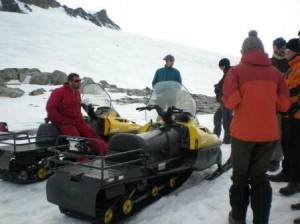
A morning of powerpoints (including information on what to do as a co-pilot) and tours around the buildings and then an afternoon of fun on the skidoos and gators (golf buggy). It is a little chilly and overcast today but still very very beautiful.
We went for a walk around Rothera point which is about 45 minutes. There were terns, elephant seals, weddell seals, blue eyed shags. The water is still very clear as the summer algae bloom hasn’t started yet so the iceberg parts under water are very clear. There are four huge bergs grounded off the point at the moment and the cove on the north end of the runway is full of broken up sea ice and icebergs.
After our walk and the last twin otter had landed we got clearance to go for a 3 km run around the runway. Wow I am unfit… I am working up to the 10km run at New Years Eve which is 5.5 times around the runway. So I figure if I run 1.5 times around every day this week and next week 2 times the week after 2.5 times I might complete the run. I will for sure be lapped but completion is all I am aiming for. It is cold out there and with a headwind it is a hard run!
I am now into day 2 of no chocolate so we will see how my new resolution goes. The chocolate pudding with custard was so very tempting. Adam the navy pilot I came down here with has given up alchol till mid February. Claire the docter has given up that would be too embaressing for her if I put it on my blog!
Holy Sh** we are here
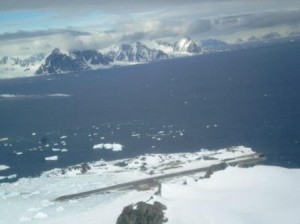
We are in Rothera finally it is amazing… I got to fly in the jump seat for take off from Falklands and then was in the pilot seat on the Dash 7 for part of the Drake’s Passage crossing.
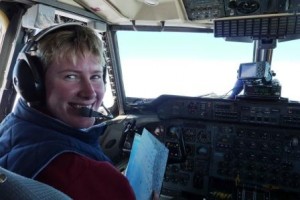
Wow can’t believe I am here.
Induction training starts tomorrow with aircraft familiaristaion, health and safety, station comms, environmental and medical, station tour, vehicle familirisation and a walk around the point.
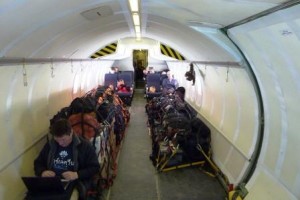
Have to go to bed as I am really tired but it is bright sunlight out 🙂
Have a great week.
In Stanley
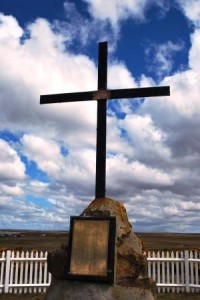
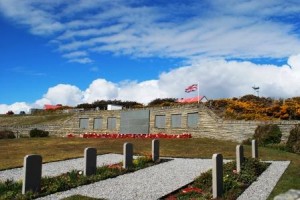
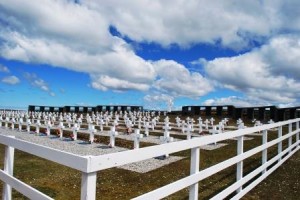
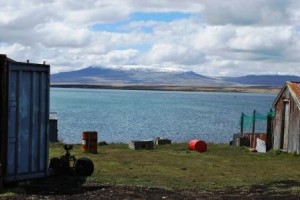
Went to see the battlefieds today in the Falklands. Long trip to get here left thursday from the UK stopped at Madrid, Santiago, Punta Arenas, Gallegos and now at Stanley. It is bleak here in comparison to the lushness of Santiago and there is snow on the higher ground.
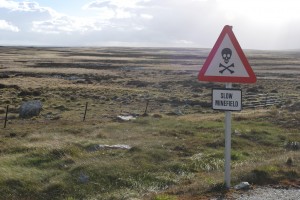
Tomorrow we are set to fly south on the Dash 7 however, this is weather dependent.
Less than 24 hours in Santiago
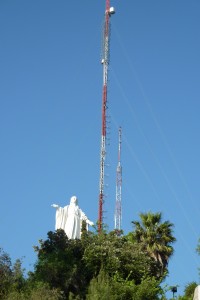
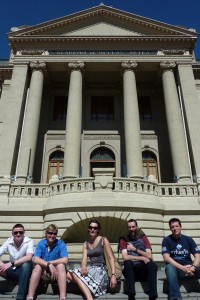
We flew Iberia from London to Madrid and spent 4 hours at the airport before a 14 hour flight to Santiago getting in early in the morning. By midday we were out on the tourist trail taking the underground into the center. We walked around the city center taking in all the old buildings before heading to the zoo and up the mountain that Santiago is built around. Dinner was at a resturant 16 floors up which revolved giving us amazing view over the Andes.
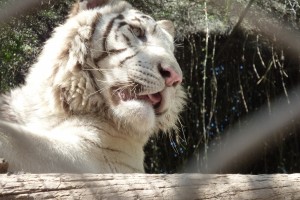
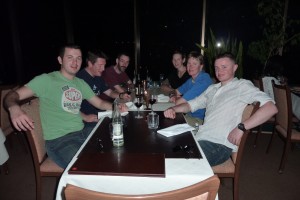
Antarctica glacier retreat creates new carbon dioxide store
This press release is from BAS. I was diving with Lloyd and David (authors of the study) in Oban in September and will be working with them down south this season.
9th November 2009
Large blooms of tiny marine plants called phytoplankton are flourishing in areas of open water left exposed by the recent and rapid melting of ice shelves and glaciers around the Antarctic Peninsula. This remarkable colonisation is having a beneficial impact on climate change. As the blooms die back phytoplankton sinks to the sea-bed where it can store carbon for thousands or millions of years.
Reporting this week in the journal Global Change Biology, scientists from British Antarctic Survey (BAS) estimate that this new natural ‘sink’ is taking an estimated 3.5 million tonnes* of carbon from the ocean and atmosphere each year.
Lead author, Professor Lloyd Peck from BAS says,
“Although this is a small amount of carbon compared to global emissions of greenhouse gases in the atmosphere it is nevertheless an important discovery. It shows nature’s ability to thrive in the face of adversity. We need to factor this natural carbon-absorption into our calculations and models to predict future climate change. So far we don’t know if we will see more events like this around the rest of Antarctica’s coast but it’s something we’ll be keeping a close eye on.”
Professor Peck and his colleagues compared records of coastal glacial retreat with records of the amount of chlorophyll (green plant pigment essential for photosynthesis) in the ocean. They found that over the past 50 years, melting ice has opened up at least 24,000 km2 of new open water (an area similar to the size of Wales) – and this has been colonised by carbon-absorbing phytoplankton. According to the authors this new bloom is the second largest factor acting against climate change so far discovered on Earth (the largest is new forest growth on land in the Arctic).
Professor Peck continues,
“Elsewhere in the world human activity is undermining the ability of oceans and marine ecosystems to capture and store carbon. At present, there is little change in ice shelves and coastal glaciers away from the Antarctic Peninsula, but if more Antarctic ice is lost as a result of climate change then these new blooms have the potential to be a significant biological sink for carbon.”
ENDS
Issued by the British Antarctic Survey Press Office
Author’s contact details:
Professor Lloyd Peck. Tel: +44 (0)1223 221603; email LSPE@bas.ac.uk
Notes for editors:
Stunning broadcast-quality footage and stills of Antarctica, as well as location maps are available from the BAS Press Office as above.
Negative feedback in the cold: ice retreat produces new carbon sinks in Antarctica by Lloyd S. Peck, David K. A. Barnes, Alison J Cook, Andrew H Fleming and Andrew Clarke is published online this month in the journal Global Change Biology.
Phytoplankton use chlorophyll and other pigments to absorb sunlight for photosynthesis, and when they grow in large numbers, they change the way the ocean surface reflects sunlight. They are eaten by krill and are the foundation of the ocean food web. Animals such as sponges and corals also consume phytoplankton. They can live for decades to hundreds of years and when they die they form mats on the seabed that are buried under sedimentation.
*The 3.5 million tonnes of carbon taken from the ocean and atmosphere is equivalent to 12.8 million tonnes of CO2.
Global carbon dioxide emissions from fossil fuel combustion and land use change reached 8.7 billion tonnes of carbon in 2007.
Sea ice loss and retreat of coastal glaciers on the Antarctic Peninsula were studied using historical accounts, aerial photographs and satellite images. This shows that seven of the major ice shelves and 87% of the 244 marine glaciers have retreated over the past 50 years.
The 24,000 km2 of new open water is approximately the size of Vermont, New Hampshire, New Jersey, Belize or Israel.
A glacier — is a ‘river of ice’ that is fed by the accumulation of snow. Glaciers drain ice from the mountains to lower levels, where the ice either melts, breaks away into the sea as icebergs, or feeds into an ice shelf.
Ice sheet — is the huge mass of ice, up to 4km thick that covers bedrock in Antarctica or Greenland. It flows from the centre of the continent towards the coast where it feeds ice shelves.
Ice shelf — is the floating extension of the grounded ice sheet. It is composed of freshwater ice that originally fell as snow, either in situ or inland and brought to the ice shelf by glaciers. As they are already floating, any disintegration will have no impact on sea level. Sea level will rise only if the ice held back by the ice shelf flows more quickly onto the sea.
British Antarctic Survey (BAS), a component of the Natural Environment Research Council, delivers world-leading interdisciplinary research in the Polar Regions. Its skilled science and support staff based in Cambridge, Antarctica and the Arctic, work together to deliver research that underpins a productive economy and contributes to a sustainable world. Its numerous national and international collaborations, leadership role in Antarctic affairs and excellent infrastructure help ensure that the UK maintains a world leading position. BAS has over 450 staff and operates five research stations, two Royal Research Ships and five aircraft in and around Antarctica.
The importance of packing!
As I pack my one bag to take to Antarctica I not only have to comply with the 23kg baggage allowance but I also need to make sure everything is clean and that I am not inadvertently carrying non native species to Antarctica.
Jill the Head of Building Section at BAS was going to the Falkland last weekend on the MOD flight for a quick trip so very kindly took my skis and ski boots down saving me 120 Euros in excess baggage allowance on Lan Chile. I am looking forwad to getting some post work evening ski trips in.
My bag contains some clothing to compliment what BAS has already given me for work including some base layer socks (thin ones) and gloves. I also have a nice new mid layer for diving in and under my boat suit it is like wearing a sleeping bag toasty and warm… Lots of handwarmers including some ones that you recharge by boiling, my new SLR camera with waterproof case, deodrant, conditioner, after work clothes etc. I am hoping I have pretty much everything I will need.

